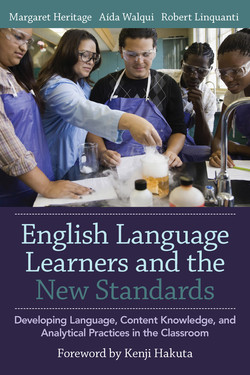Читать книгу English Language Learners and the New Standards - Margaret Heritage - Страница 7
ОглавлениеForeword
We educators are in Wave 3 of standards-based reform—the third successive wave of energy unleashed by A Nation at Risk.
The first wave started over thirty years ago, in the throes of the Reagan administration, when many of us were still tinkering with the early toys of the computer revolution and Ford Pintos were exploding upon impact, signaling the decline of American industry. Concerned, the nation marched into the world of standards-based education to improve our schools. A Nation at Risk was published in 1983 and launched a string of federally encouraged state-led efforts to improve education through aspiration for world-class standards. Governor Bill Clinton joined the act and passed signature legislation when he became President, known as Improving America’s Schools Act, setting state standards in place.
Wave 2 came as No Child Left Behind, under George W. Bush, adding teeth to the assessment system for purposes of accountability. During this wave, the section of the law that provides federal aid to English language learners (ELLs), known as Title III, added assessment of student English language proficiency (ELP) as a requirement, and an accountability system was set up to set performance targets, monitor results, and require corrective actions.
And now we have a commitment to a new set of standards for “college and career readiness,” which in many states are referred to as the Common Core State Standards and the Next Generation Science Standards. Starting in 2015, new assessment systems will be in place in many states to measure student proficiency in these standards. Also available will be new assessment systems for the English language proficiency of ELLs that are aligned to revised ELP standards that “correspond” to the language demands inherent in the content standards. These new and demanding standards represent the third wave of standards-based reform.
The authors of this book describe education policy as “a prescribed course of action that encodes key values of those that make and enact policy prescriptions.” In all three waves of reform, the “encoded key value” in the policy has been an emphasis on assessment for accountability purposes. This emphasis is due to the governing philosophy of “deregulation and flexibility in exchange for results”—a system that provides incentives and penalties for outcomes (rather than focusing on regulating inputs), and lets the invisible hand guide the actions of systems. This idea started with Reagan, was embraced by Clinton, and grew teeth under G. W. Bush.
In English Language Learners and the New Standards, Margaret Heritage, Aída Walqui, and Robert Linquanti perform a remarkable jujitsu act—taking the energy of this wave of reform and training it on the context of instruction. What this book tells us, and illustrates through a portrayal of learning processes and learning progressions in real classrooms, is that this emphasis on assessment for accountability generates a systemic focus on results, but does not travel further to instruction. The authors’ jujitsu act is to build a channel that guides this energy by emphasizing the kinds of instructional practices that exemplify learning and support individual student learning. That is to say, formative assessment is highlighted, featured, and modeled as a set of practices that supports student learning, rather than as an external agent of system, teacher, and student accountability.
The ambitious and sophisticated nature of this work is reflected by the range of knowledge, expertise, and experience of the three authors. Margaret Heritage is best known as the articulate and passionate spokesperson for the understanding of formative assessment practice. She has spent much of her career illustrating and advocating for what Black and Wiliam characterize as a “process used by teachers to recognize and respond to student learning, in order to enhance that learning, during the learning.” Aída Walqui is a highly accomplished champion of teacher professional development who has moved the field of English language learners from a bifurcated view of learning (in this class, we work on the student’s grammar, and in that class, we work on math) to an integrated one. Throughout her career, by her actions as well as by her shaping of the theoretical literature on second-language acquisition, she has created pathways between the two solitudes—the ESL teacher and the “mainstream” content teacher. And Robert Linquanti is the prime “policy wonk” of systems of assessment and accountability for ELLs, and has analyzed and surfed the successive waves of reform with an eye to giving all students access to meeting the standards. He is probably the most influential policy analyst and actor in the field for states and many school districts.
The book has an ambitious agenda, bringing these formidable actors together to provide a narrative to model and envision what assessment practice must look like during the present context of reform. It creates pathways between assessment and instruction, policy and practice, and above all, between language and academic content. Undoubtedly, the will for reform is still generated by the philosophy of flexibility of means for accountability of results. However, this book takes this framework and illustrates how the teaching profession can adapt and shape instruction for ELLs based on continual evidence of student learning. This is a deft move, and could not have been made at a better moment.
As the nation moves to the implementation of the new standards, readers will find great inspiration in the authors’ vision of what learning can become for ELLs, and in their real examples of the powerful pedagogy, responsive assessment, and coherent policy required to get there.
—Kenji Hakuta Lee L. Jacks Professor of Education Stanford Graduate School of Education
